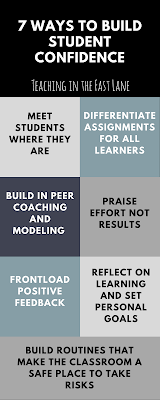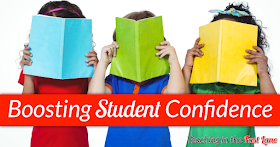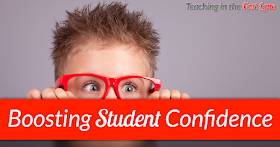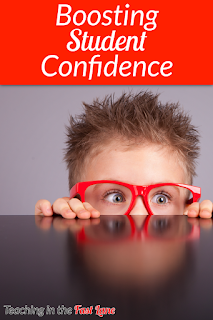School can be a tough place for a student that lacks self-esteem. The classroom can feel full of traps waiting to catch a student off guard and derail their confidence.
As teachers, we need to work with our students to build their confidence in a way that encourages them to take risks and grow daily. When this is achieved, our students can truly flourish.
The Amazon links in this post are affiliate links, meaning that if you click and buy an item Amazon throws a little bit back to me to support this blog. It does not in any way change the price of your item. Thank you!
Meet Students Where They Are
A classroom full of students is likely coming to you from a variety of backgrounds, levels, and experiences. When you teach to the middle you are likely to miss a big chunk of students.
When beginning a new unit or topic activate prior knowledge and have students share their experiences. This serves to build community within your classroom and allows students to show you what they know and where there may be misconceptions. Be careful not to correct these misconceptions right away, but instead guide learning to correct them over time.
By meeting students where they are you show them they have prior knowledge and something to add to the conversation. Their ability to contribute shows them and the class their input is valued.
 Differentiate
Differentiate
Differentiation is a big buzzword in education, as it should be. When we meet students where they are we can then differentiate their learning to accelerate those who are missing pieces and enrich the learning for all.
Differentiation works in both directions. We can scaffold learning for those that have missing pieces, as well as challenge our students to go deeper when they already understand a topic. It is important to remember that with each new topic or unit students will need to be evaluated for misconceptions or prior understanding. We cannot make the mistake of grouping students once and keeping the same groups all year.
Sometimes differentiation means a different assignment or way of working through a topic, other times it means doing the same assignment, but in a different format. As the professional, you know your students and what is best for them.
Want to Save This Post for Later?
Subscribe to get your own PDF of the post and updates from
Teaching in the Fast Lane!
Build in Peer Coaching
Want to Save This Post for Later?
Subscribe to get your own PDF of the post and updates from
Teaching in the Fast Lane!
Teaching in the Fast Lane!
When students work together in heterogeneous groups they automatically model learning, listening, and speaking for one another. By allowing students time to work with their peers through structured activities with a common goal students are able to scaffold for one another and enrich the learning experience for everyone.
Cooperative learning strategies are the perfect example of students working together towards a common goal. When each student fulfills a role, they scaffold one another's learning and allow the teacher to facilitate rather than lead the learning.
One of my favorite strategies for getting students to verbalize their thinking and coaching one another is Rally Coach.
Praise Effort
Often our students get so tied up in results that they negate all the hard work they have put in when they don't achieve their goal on the first try.
By praising effort instead of results we show our students that hard work leads to big things and failure is an opportunity to try again with some background knowledge.
This approach fits right in with growth mindset, which shows us the power of yet. When we can adjust our students thinking from I can't do this, to I can't do this YET big things happen.
Some great books (affiliate links) to support growth mindset in our students are:
Frontload Positive Feedback
No matter whether you are a child or an adult feedback can make or break your experience.
Imagine this:
You are out at recess with your students and they are teaching you a new game, but you, being you, are terribly uncoordinated and having a hard time being successful. Are your students going to walk away and say better luck next time? I would bet not!
Our students are incredibly patient with us when showing us how to do something new, but they aren't always so kind to themselves. This is why, as teachers, we must step in to model positive self-talk as well as frontload our students with positivity.
Research states that we should be offering up three pieces of positive feedback for every negative piece. This becomes that much easier when you start positive instead of trying to dig yourself out of a hole later.
By continuing to praise effort, positive feedback becomes much easier as well.
Think about long division. How many times does using the standard algorithm offer a teacher the chance to provide positive feedback to a student? You guessed it, a whole bunch of times. By praising students' effort all along the way it is easier to take when a mistake is made and corrections are needed. It isn't self-esteem shattering either.
Reflect on Learning and Set Personal Goals
Not everyone is going to get everything perfect on the first try, and if you do, you are not living in the real world.
By celebrating effort and using mistakes as a platform to hone your skills student confidence can grow.
Allow time for students to think about their learning. What they have tried and done well in, and areas where they need to grow some more. Emphasize the opportunity that students have to grow and help them to set personal goals that can be celebrated when they are achieved.
In my experience, it is best to set three to four learning goals with students at a time. The first two or three should be quickly attainable and just outside of their reach, and then the last goal can be a bit more of a stretch and longer term. Double bonus points if the first few goals get them closer to the final goal!
 Build Routines
Build Routines
We all know students thrive on routine, but did you know that routine in the classroom builds student confidence and encourages risk-taking?It is as simple as this: when you know you are in a safe place and can predict the outcome to a certain extent you are more likely to give something new a try.
By providing our students with a bit of predictability they know they will be supported and encouraged to take risks. This leads to bigger leaps in learning, achieving goals, and high self-esteem which in return leads to more risk-taking.
We can provide routine in the classroom without making the day monotonous. For example, our math block always included the same structure of warm-up, mini-lesson, practice, stations and small group, and then exit ticket. While the order and structure stayed the same we varied what practice would look like through cooperative learning strategies, problem-solving activities, or opportunities to choose who you wanted to work with. Students knew practice time was the time to take risks and push their learning boundaries within the safety net of the larger math block.
In the End
Being a kid these days is tough, and the classroom should not be one of the reasons students' self-esteem suffers.
To make sure all students feel appreciated, confident, and ready to take risks:
Meet students where they are
Differentiate assignment in both directions
Build in peer coaching or scaffolding
Praise effort, not results using growth mindset principles
Frontload positive feedback
Reflect on learning and set goalsBuild routines into daily classroom activities



No comments:
Post a Comment